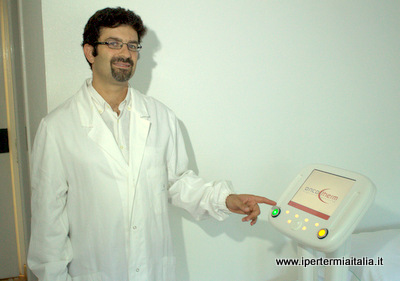Oncological Hyperthermia
Oncological Hyperthermia a novel approach in cancer cure
Hyperthermia in cancer therapy

Hyperthermia is a useful technique for therapy on solid tumors, based on a radiofrequency of 13,56 MHz, applied to generate heat deep with tissues.
Heat has always been object of study on the part of the medical science community. The supply of energy through hyperthermia produces a change in the homeostasis of cellular systems.
Certain conditions are particularly favoured by hyperthermia. In my experience as oncology doctor, specialised in anti-tumour chemotherapy, I have been able to verify the usefulness of an integrated approach to oncologic pathology. In reality the complexity of the cancer phenomenon calls for a multi-modal treatment.
And it is in this perspective that we consider oncologic hyperthermia, in combination to surgery, to chemotherapy, and to radiotherapy in its manifold facets.
Speaking in detail about hyperthermia, it is worth illustrating its potentialities, the fields of application and its practice on patients.
The equipment for deep oncologic hyperthermia is endowed with emitters (antennae) at 13.56 Mhz. which, positioned on the patient’s body in correspondence to the sick organ, one in front and the other on the back, produce a deep increment (42° to 43°C) in the organ’s temperature.
At this temperature, tumour cells which possess an altered cellular membrane (aberrant) are not able to dispose of heat and active hyperthermia of intracellular enzymes called caspasi, break the DNA and lead the malignant cell to death (apoptosis, or programmed cellular death).
Other characteristics can be attributed to hyperthermia. Primarily, it facilitates chemotherapy in gaining access on the target, above all in areas which are not well vascularised (for example the peritoneum) which represent the so-called pharmacological niche, where medication finds it hard to get there or is delivered badly.
Certain types of chemotherapy present better results if administered with hyperthermia (see article on the website). The alteration of loco-regional vascularisation provoked by hyperthermia, renders the environment less suitable for the proliferation of tumoral cells.
Radiotherapy combined with hyperthermia obtains better effect by summation of damage and by inducing the damaged cells to death in a sub-lethal way. Last but not least, hyperthermia induces stimulation of the immune system.
Cytokines are released locally stimulating the arrival of leucocytes in situ, therefore there is major strength in the struggle against sick cells. Hyperthermia is indicated in all solid tumours, on condition that there is no pleuric or massive ascetic effusion.
In these conditions it is preferable to drain the liquid before carrying out hyperthermia.
Even haematological neoplasms receive benefit if there are lymph-nodal packets (pockets) Hyperthermia can also be applied to osteo-arthro-muscular pathology. The use in rheumatology is well-known and the same equipment we dispose of (Synchrotherm RF 13.56) can be used for this objective.
The device is regulated to a different power and to minor exposure to the radiofrequency. In this way it is possible to obtain great benefit through analgesic activity (which can also be obtained in tumour pain), anti-inflammatory activity, relief from contractures, arthrosic pain, rigidity and muscular spasm.
In substance hyperthermia represents a valid ancillary method in tumour therapy, and in the resolution of osteo-arthro-muscular pathology.

